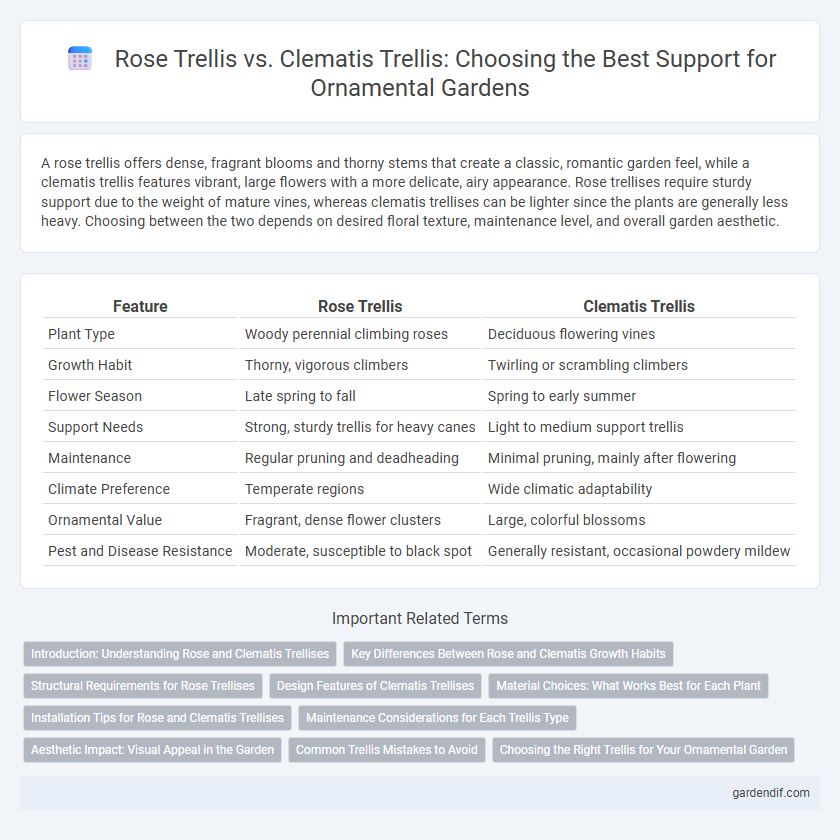
Rose Trellis vs Clematis Trellis Illustration
A rose trellis offers dense, fragrant blooms and thorny stems that create a classic, romantic garden feel, while a clematis trellis features vibrant, large flowers with a more delicate, airy appearance. Rose trellises require sturdy support due to the weight of mature vines, whereas clematis trellises can be lighter since the plants are generally less heavy. Choosing between the two depends on desired floral texture, maintenance level, and overall garden aesthetic.
Table of Comparison
| Feature | Rose Trellis | Clematis Trellis |
|---|---|---|
| Plant Type | Woody perennial climbing roses | Deciduous flowering vines |
| Growth Habit | Thorny, vigorous climbers | Twirling or scrambling climbers |
| Flower Season | Late spring to fall | Spring to early summer |
| Support Needs | Strong, sturdy trellis for heavy canes | Light to medium support trellis |
| Maintenance | Regular pruning and deadheading | Minimal pruning, mainly after flowering |
| Climate Preference | Temperate regions | Wide climatic adaptability |
| Ornamental Value | Fragrant, dense flower clusters | Large, colorful blossoms |
| Pest and Disease Resistance | Moderate, susceptible to black spot | Generally resistant, occasional powdery mildew |
Introduction: Understanding Rose and Clematis Trellises
Rose trellises feature sturdy frameworks designed to support the heavy growth and large blooms of climbing roses, often made from metal or hardwood to withstand their weight. Clematis trellises are typically lighter structures with finer grids, accommodating the delicate vines and tendrils of clematis for optimal climbing and flowering. Both trellises enhance vertical garden spaces but vary significantly in material durability and design to suit the specific growth habits and weight of each plant.
Key Differences Between Rose and Clematis Growth Habits
Rose trellises support vigorous climbing roses that develop thick, woody stems and require sturdy structures to anchor heavy blooms and frequent pruning to maintain shape. Clematis trellises accommodate vines with flexible, twining petioles that cling gently and grow rapidly in layered, vertical patterns, needing lighter support and minimal structural reinforcement. These growth habits influence trellis design choices, with roses demanding robust, load-bearing frameworks and clematis thriving on delicate, open lattices.
Structural Requirements for Rose Trellises
Rose trellises require sturdy, weight-bearing structures often made from heavy-duty wood or metal to support the dense, woody vines and frequent pruning growth of rose plants. The framework must ensure proper airflow and sunlight penetration to prevent fungal diseases common in roses, necessitating a design with wider spacing between slats or bars. Unlike clematis trellises, rose trellises demand more substantial anchoring and stability to withstand the increased weight and seasonal growth cycles characteristic of climbing roses.
Design Features of Clematis Trellises
Clematis trellises often feature intricate lattice patterns that support the vine's delicate tendrils while enhancing airflow and sunlight exposure, promoting healthier growth. Common designs include fan-shaped, vertical panels, and freestanding arches that accommodate the sprawling nature of clematis plants. Materials such as wrought iron or wood are favored for their durability and ability to blend seamlessly with garden aesthetics, providing both functional support and decorative appeal.
Material Choices: What Works Best for Each Plant
Rose trellises are best crafted from sturdy materials like cedar or treated wood, which provide strong support for heavy, woody stems and withstand outdoor elements without rotting. Clematis trellises benefit from lightweight, rust-resistant metals such as wrought iron or aluminum, allowing delicate vines to climb easily while maintaining durability. Combining material strength with plant growth habits ensures optimal support and longevity for both rose and clematis trellises.
Installation Tips for Rose and Clematis Trellises
For optimal installation of rose trellises, position them in well-drained soil with full sun exposure and ensure sturdy support to accommodate heavy growth and thorns. Clematis trellises require placement where roots remain shaded and cool while the plant climbs into sunlight, combined with secure anchoring to support their lighter, twining stems. Both trellises benefit from regular pruning and training to maintain shape and promote vigorous blooming.
Maintenance Considerations for Each Trellis Type
Rose trellises typically require regular pruning to promote healthy growth and prevent overcrowding, along with vigilant pest management to maintain vibrant blooms. Clematis trellises demand consistent watering and timely deadheading to encourage continuous flowering, while ensuring the base of the plant remains shaded and cool. Both trellis types benefit from routine inspection for structural stability to support the weight of mature plants effectively.
Aesthetic Impact: Visual Appeal in the Garden
A rose trellis offers a classic and romantic aesthetic with lush blooms and dense foliage that create a timeless garden focal point. Clematis trellises provide vibrant color variety and delicate, star-shaped flowers that add an airy, whimsical charm to vertical garden spaces. Both structures enhance garden depth, but the choice between them depends on the desired visual impact, with roses emphasizing richness and clematis highlighting lightness.
Common Trellis Mistakes to Avoid
Choosing the right trellis for roses or clematis is crucial to prevent common mistakes like using inadequate support structures that can collapse under the plant's weight. Roses require sturdy, weather-resistant trellises with wider spacing to accommodate heavy woody stems, while clematis prefers lighter trellises with closer slats for its delicate tendrils to grip securely. Avoiding improper placement that limits sunlight exposure and ensuring proper pruning techniques are essential to maximize growth and flowering for both rose and clematis trellises.
Choosing the Right Trellis for Your Ornamental Garden
Selecting the ideal trellis for your ornamental garden depends on the growth habits and bloom characteristics of your plants. A rose trellis typically supports heavy, woody stems and encourages vertical growth, making it perfect for climbing roses that require sturdy support and space to spread. Clematis trellises are designed to accommodate delicate, twining vines and flourish best when positioned to maximize sunlight exposure and airflow, enhancing flower production and overall plant health.
Rose Trellis vs Clematis Trellis Infographic

 gardendif.com
gardendif.com